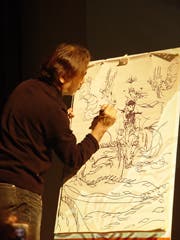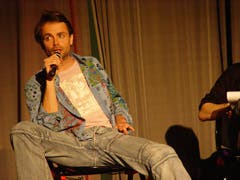Character Study
Yoshitaka Amano and Michel Ancel discuss design.
Paris has recently, it seems, been a hive of activity for videogame creators. On Monday March 13, two French game designers - Michel Ancel (Rayman, Peter Jackson's King Kong), and Frederick Raynal (Alone in The Dark, Little Big Adventure) were joined by Nintendo's legendary Shigeru Miyamoto to receive from the French Minister of Culture a medal with the honorific title of Chevalier dans l'Ordre des Arts et des Lettres (Knight in the Order of Arts and Literature) - one of the highest honours the French government can bestow on any creative or artistic talent. And the weekend prior to this ceremony, the fourth annual Carrefour de l'animation (Animation Crossroad) cultural show offered the opportunity, for a small audience of passionate fans, animation and videogame students, to attend several conferences by another legend from Japan : Yoshitaka Amano, the painter-illustrator behind the imagery and character design of most of Square's Final Fantasy games since 1987. One of these conferences had a particularly original ideal - putting Amano and French game designer Michel Ancel on the same stage to talk about game and character design.
Le Carrefour de l'animation took place this year in a huge building of the Museum of Sciences and Industry in the north of Paris. Since October 2005 this museum - which includes, amongst many installations, an IMAX theater, a Planetarium and even some videogame booths and old consoles under windows - is receiving a big Star Wars exhibition that draws family crowds (open until august 2006). The Carrefour de l'animation event occupies only a small part of the building and for three days, digs into the craft of animated movies and videogames through conferences, workshops and movie screenings. The long due direct to video release (April 24 on DVD and UMD in UK) Final Fantasy VII: Advent Children was shown on a big screen Saturday night, while on Sunday, it was the turn of the animated movie Angel's Egg (Tenshi no Tamago, 1985) an early and experimental collaboration between famous movie director Mamoru Oshii (Avalon, Ghost in the Shell) and Yoshitaka Amano.

After checking out the booth of the renowned Supinfogame school of videogames from the northern French city of Valenciennes, where several burgeoning videogame projects were shown and explained on LCD screens and on a big rear-projection screen, we were invited to the auditorium to witness the meeting of Yoshitaka Amano and Michel Ancel on stage. Tommy François, a usually agitated animator from the French videogame cable TV channel GameOne, did a pretty good and sober job as the moderator for the discussion, as did the interpreter Llan Nguyên who helped the audience with very subtle translations to tentatively grasp the thoughts of Amano-san.
The two game artists were united on stage under the banner of character design but it quickly emerged that both men had a very different approach. Whether in original work or under an order from, say, Square, Amano-san doesn't really bother himself with whether his drawings and suggestions will be adjustable or not to a videogame. As he put it himself: "They come to me with some general directions, and it's my job to fill in all the details that finally give the personality of a scene or a character". He then explained, and later demonstrated for the audience, that he always starts a new illustration with a tiny detail that might be drawn at the far end of the blank page before becoming an impressive scene filling a full page. The only tools he uses are art pencils and brushes.

Michel Ancel, who admittedly is from a younger generation, didn't go to any art school and didn't work in the animation industry like Amano-san. He designed the Rayman character directly with PC software as he was already looking to create a videogame hero able to perform several actions. As is often the case, the unique nature of Rayman - who doesn't have any arms or legs - was at the time born out of technical issues rather than a real design objective. Ancel revealed that he and his team even tried to introduce arms and legs to Rayman for the first 3D version of the game, but soon realized how much the absence of visual limbs belonged to the cute character.
For his Beyond Good & Evil game, Ancel had to modify the look of his female hero Jade several times - to be more marketable, we assume - while of course, for his collaboration on Peter Jackson's King Kong, he didn't really have to invent any characters. As a direct opposite to Amano-san's full freedom of creation with his pencils, Ancel explained several times how difficult it was to find the right balance of design and technological possibilities: "If I want long hair on my character, then I have to animate it properly, but how much processor power can we allow considering that I want to put her in a wide open world with plenty of other moving objects and people?" And such questions arise anew for each new generation of console.

Apparently far above such considerations, Amano-san admitted with indifference that his drawings were scaled down when used for the Final Fantasy games. "My drawings are exaggerated 130% in that perspective" he then revealed, while pointing out that the technology was allowing videogames to get closer and closer to his illustrations. "The 3D process doesn't really concern me", he pointed out. "We always look at it on a flat surface, don't we?" Reluctant to endorse any influence beyond the Austrian painter Klimt (1862-1918) and his Japanese roots, the artist seemed much more interested in the present and the future: "I do believe that 3D tools will one day lead to another step in the evolution of arts, as the Renaissance did in Europe in the 15th and 16th century."
To conclude the conference, the moderator proposed a little game of improvisation to the two artists. Yoshitaka Amano was asked to draw a picture on a paper board while Michel Ancel, as he sometimes does with artists in his team, was to imagine game scenarios from the illustration created in front of him. Amano-san, presenting only his back to the audience, drew for about 15 minutes in a respectful silence which was doubly impressive considering the 400 hundred young crowd. Witnessing live how an artist can take off in his own creative process, we saw Amano-san feverishly draw not one but two other illustrations while bouncing ideas from Ancel's commentaries.

After the show, there was a brief opportunity for journalists to meet Michel Ancel, but unfortunately, surrounded by the mainstream press (daily newspapers, and so on) the conversation stayed superficial. Asked to comment on his Chevalier medal, Ancel could only say that he was happy to take it on the behalf of the videogame industry which, he said, needed some respectability (British academy BAFTA seems to agree, having just lifted videogames to an equal billing with the film and television industries): "When I started in the videogame business back in 1990, it was something we were almost ashamed of," he commented. Ancel also confirmed that Rayman 4 is scheduled before the end of 2006 for this current generation of consoles only.
The next day, Amano's solo conference allowed the audience to learn a little more about his amazing career, which goes way beyond the videogame industry. We even had the privilege to watch several old and new animated shorts he initiated or collaborated on. One of them, unreleased so far, will be presented at the Festival International du Film d'Animation d'Annecy in June, and we also saw another very impressive work in progress, produced by the Denis Friedman (already producer of the Kaena CGI long feature), called The Planet of the Winds - whose 3D universe and characters are based on Amano's illustrations painted during a stay in Paris. "They're all made in France", confided the Japanese artist with a rare smile.
For further reading:
